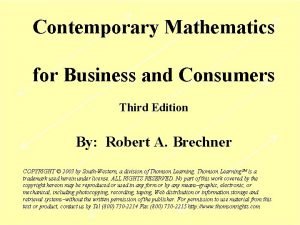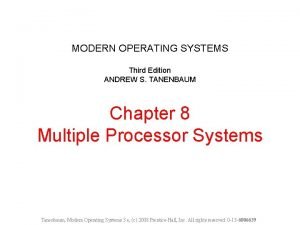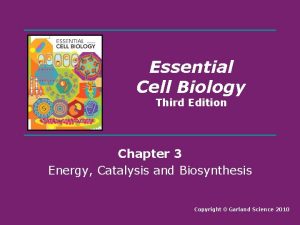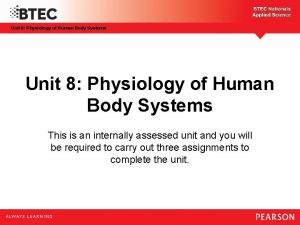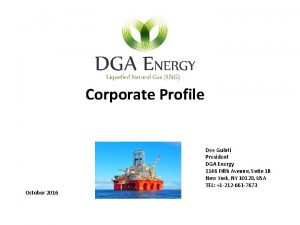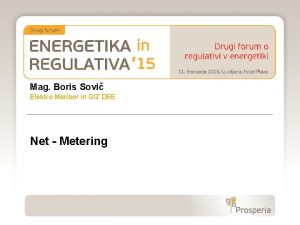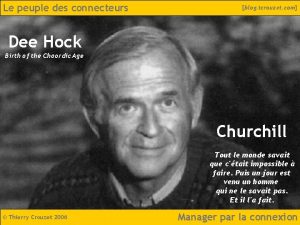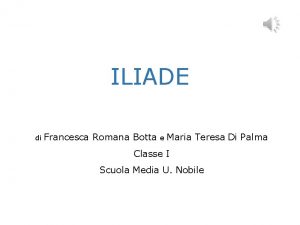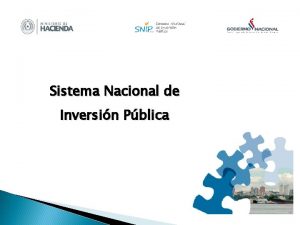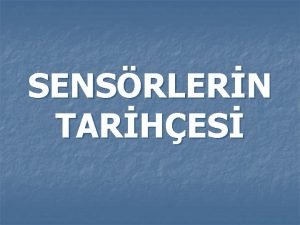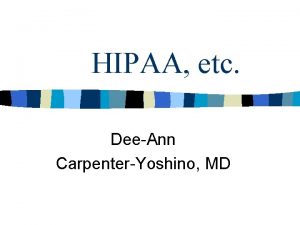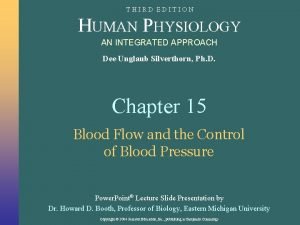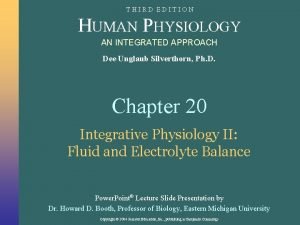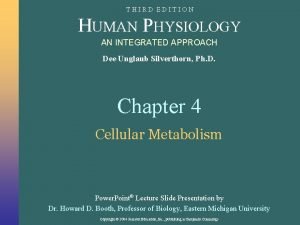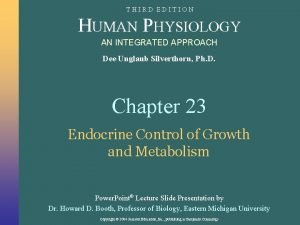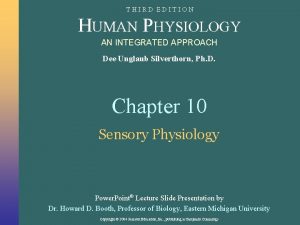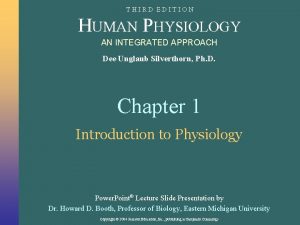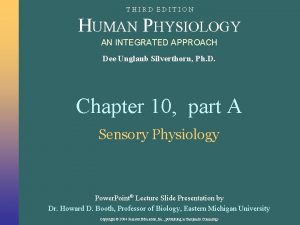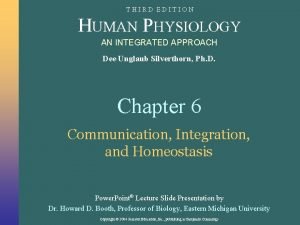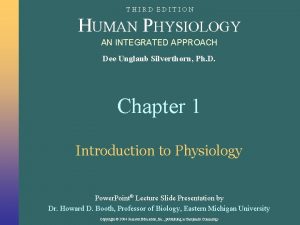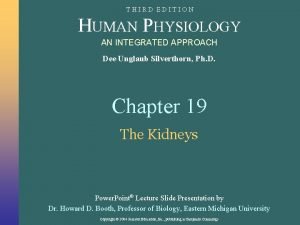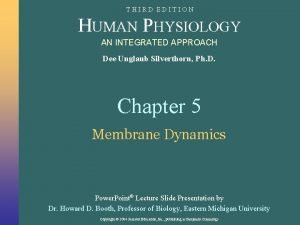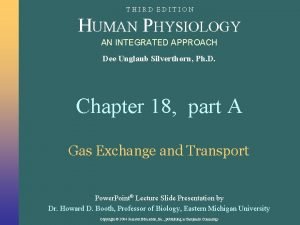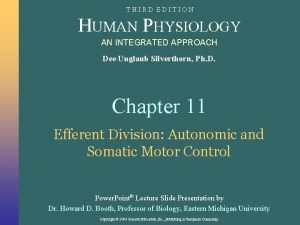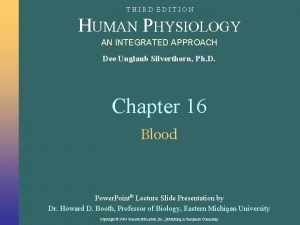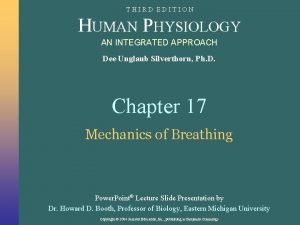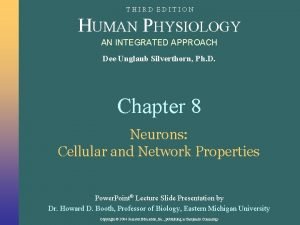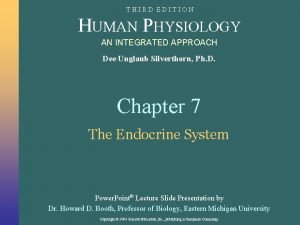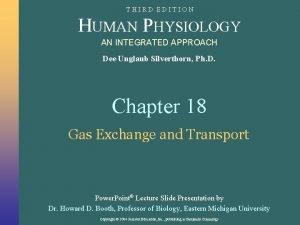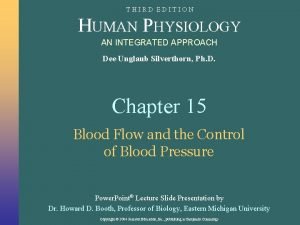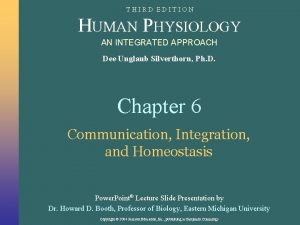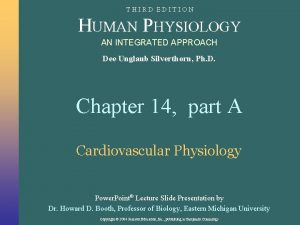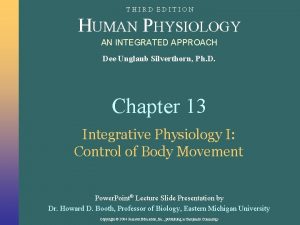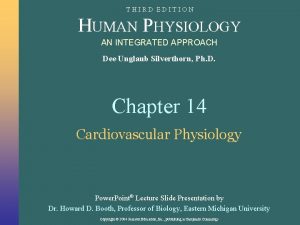THIRD EDITION HUMAN PHYSIOLOGY AN INTEGRATED APPROACH Dee


























































- Slides: 58

THIRD EDITION HUMAN PHYSIOLOGY AN INTEGRATED APPROACH Dee Unglaub Silverthorn, Ph. D. Chapter 22 Metabolism and Energy Balance Power. Point® Lecture Slide Presentation by Dr. Howard D. Booth, Professor of Biology, Eastern Michigan University Copyright © 2004 Pearson Education, Inc. , publishing as Benjamin Cummings

About this Chapter • How energy is distributed and used in humans • How nutrients are converted to the energy and building blocks for synthesis • How hormones control metabolic processes • How the body maintains a constant temperature Copyright © 2004 Pearson Education, Inc. , publishing as Benjamin Cummings

Body Energy: Eating Controls • Cortex – "hunger" • CNS Feeding center • CNS satiety center • CNS & GI peptides • Ghrelin • Leptin • Peptide YY • Insulin • CCK • CRH • Neuropeptide Y Copyright © 2004 Pearson Education, Inc. , publishing as Benjamin Cummings

Copyright © 2004 Pearson Education, Inc. , publishing as Benjamin Cummings

THIRD EDITION HUMAN PHYSIOLOGY AN INTEGRATED APPROACH Dee Unglaub Silverthorn, Ph. D. Power. Point® Lecture Slide Presentation by Dr. Howard D. Booth, Professor of Biology, Eastern Michigan University Copyright © 2004 Pearson Education, Inc. , publishing as Benjamin Cummings

Copyright © 2004 Pearson Education, Inc. , publishing as Benjamin Cummings

Copyright © 2004 Pearson Education, Inc. , publishing as Benjamin Cummings

Body Energy: Input = Output (+ storage) • Energy for temperature regulation – heat • Energy for metabolic processes – work • Transport work – move molecules • Mechanical work – muscle contraction • Chemical work – synthesis & storage • Energy use is measured by oxygen consumption • Calories in food (kilocalorie = 1 L H 2 O 1˚C) Copyright © 2004 Pearson Education, Inc. , publishing as Benjamin Cummings

Respiratory Quotient • RQ= The ratio of Pure CO 2 produced to O 2 consumed • For Pure Carbohydrate Catabolism: RQ= 1. 0 • For Pure Protein Catabolism: RQ= 0. 8 • For Pure Fat Catabolism: RQ= 0. 7 Copyright © 2004 Pearson Education, Inc. , publishing as Benjamin Cummings

Respiratory Quotient • Carbohydrates: The respiratory quotient for carbohydrate metabolism can be demonstrated by the chemical equation for oxidation of glucose: • C 6 H 12 O 6 + 6 O 2 → 6 CO 2+ 6 H 2 O • Because the gas exchange in this reaction is equal, the respiratory quotient for carbohydrates is: RQ = 6 CO 2 / 6 O 2 = 1. 0 • Fats: The chemical composition of fats differs from that of carbohydrates in that fats contain considerably fewer oxygen atoms in proportion to atoms of carbon and hydrogen. The substrate utilization of palmitic acid is: • C 16 H 32 O 2 + 23 O 2 → 16 CO 2 + 16 H 2 O • Thus, the RQ for palmitic acid is approximately 0. 7. RQ = 16 CO 2 / 23 O 2 = 0. 696 • Proteins: The respiratory quotient for protein metabolism can be demonstrated by the chemical equation for oxidation of albumin: • C 72 H 112 N 18 O 22 S + 77 O 2 → 63 CO 2 + 38 H 2 O + SO 3 + 9 CO(NH 2)2 • The RQ for protein is approximately 0. 8. RQ = 63 CO 2/ 77 O 2 = 0. 8 • Due to the complexity of the various ways in which different amino acids can be metabolized, no single RQ can be assigned to the oxidation of protein in the diet; however, 0. 8 is a frequently utilized estimate. Copyright © 2004 Pearson Education, Inc. , publishing as Benjamin Cummings

Changes in Metabolic Rate • Basal metabolic rate (BMR) • Modifying factors • Age & gender • Lean muscle mass • Physical activity level • Diet • Hormones Copyright © 2004 Pearson Education, Inc. , publishing as Benjamin Cummings

Basal Metabolism In their review, Rolfe and Brown (1997) concluded that • ∼ 10% of the oxygen consumed during BMR is consumed by nonmitochondrial processes, • ∼ 20% is consumed by mitochondria to counteract the mitochondrial proton leak, and • the remaining 70% is consumed for mitochondrial ATP production. At a whole-animal level, ATP production can be divided into • 20%– 25% for Na+, K+-ATPase activity, • 20%– 25% for protein synthesis, ∼ • 5% for Ca 2+-ATPase activity, • ∼ 7% for gluconeogenesis, • ∼ 2% for ureagenesis, • ∼ 11% for all other ATP-consuming processes. These estimates are averages over the entire animal, and the relative contribution of the different processes varies between tissues. For example, it is estimated that although Na+, K+ATPase activity constitutes only ∼ 10% of cellular energy turnover in the liver, it is responsible for ∼ 60% in brain and kidney (Clausen et al. 1991). It can be seen from these estimates that membrane-associated activities constitute a significant portion of resting metabolic activity (and thus BMR) in higher animals. Copyright © 2004 Pearson Education, Inc. , publishing as Benjamin Cummings

Copyright © 2004 Pearson Education, Inc. , publishing as Benjamin Cummings

Copyright © 2004 Pearson Education, Inc. , publishing as Benjamin Cummings

Summary of Metabolic Conversions of Nutrients • Nutrients are used, or stored • In general glucose, fats & AAs can be interconverted Copyright © 2004 Pearson Education, Inc. , publishing as Benjamin Cummings

Summary of Metabolic Conversions of Nutrients Figure 22 -2: Summary of metabolism Copyright © 2004 Pearson Education, Inc. , publishing as Benjamin Cummings

Metabolic Proscesses: Reversible Conversions • Glycogenesis (glucose to glycogen) • Glycogenolysis (glycogen to glucose) • Gluconeogenesis (amino acids to glucose) • Lipogenesis (glucose or FFAs to fats) • Lipolysis (fats to FFAs & glycerol) Copyright © 2004 Pearson Education, Inc. , publishing as Benjamin Cummings

Metabolic Energy Production: Review & Overview • Reactants: glucose • Glycogen, FFAs • Amino acids • Phosphoylation • Glycolysis–cytoplasm • 2 ATPs, anaerobic • Citric Acid Cycle-2 ATPs, mitochondria, aerobic • Electron Transport system • High energy e-, 32 ATPs Copyright © 2004 Pearson Education, Inc. , publishing as Benjamin Cummings

Metabolic Energy Production: Review & Overview Figure 22 -3: Summary of biochemical pathways for energy production Copyright © 2004 Pearson Education, Inc. , publishing as Benjamin Cummings

“Fed State” or Absorptive Metabolism: Anabolic Processes • Reversible pathways shift to anabolic processes • Carbohydrates energize synthesis & storage • Amino Acids built into proteins, surplus stored Copyright © 2004 Pearson Education, Inc. , publishing as Benjamin Cummings

“Fed State” or Absorptive Metabolism: Anabolic Processes Figure 22 -4: 4 Dual (push-pull) control of metabolism Copyright © 2004 Pearson Education, Inc. , publishing as Benjamin Cummings

Fat Metabolism: Long Term Nutrient Storage • In adipose cells • In blood: HDL, LDL • FFAs, cholesterol • (plaque build up) • Conversion in liver • Excreted in bile • Used for energy & synthesis Copyright © 2004 Pearson Education, Inc. , publishing as Benjamin Cummings

Fat Metabolism: Long Term Nutrient Storage Copyright © 2004 Pearson Education, Inc. , publishing as Benjamin Cummings Figure 22 -5: Transport and fate of dietary fats

“Fasted State” or Post-Absorptive Metabolism: Catabolic • Pathways shift to maintain energy for metabolism • Storage glucose in blood organs in need Copyright © 2004 Pearson Education, Inc. , publishing as Benjamin Cummings

“Fasted State” or Post-Absorptive Metabolism: Catabolic Copyright © 2004 Pearson Education, Inc. , publishing as Benjamin Cummings Figure 22 -6: Fasted-state metabolism

Pancreatic Hormones, Insulin & Glucagon Regulate Metabolism • Beta cells produce insulin – cellular uptake of blood glucose • Alpha cells produce glucagon – blood glucose (from cells) • D cells produce somatostatin – gastric secretion Copyright © 2004 Pearson Education, Inc. , publishing as Benjamin Cummings

Pancreatic Hormones, Insulin & Glucagon Regulate Metabolism Figure 22 -7 b: The endocrine pancreas Copyright © 2004 Pearson Education, Inc. , publishing as Benjamin Cummings

Pancreatic Hormones, Insulin & Glucagon Regulate Metabolism Figure 22 -8: Metabolism is controlled by insulin and glucagon Copyright © 2004 Pearson Education, Inc. , publishing as Benjamin Cummings

Lipohypertrophy in a Patient • A 55 -year-old man with a 31 -year history of type 1 diabetes mellitus presented for a routine clinical evaluation, his first in two decades. His insulin regimen consisted of a combination of neutral protamine Hagedorn (NPH) and rapidacting insulin. In the many years since his diabetes diagnosis, he had habitually injected insulin into two locations in the periumbilical region. Two discrete subcutaneous masses were palpated. Both masses were firm and pendulous. A clinical diagnosis of insulin-induced lipohypertrophy was made. This condition has been documented with many insulin preparations. Careful attention should be paid to the teaching of correct methods of insulin injection, site rotation, and routine inspection of injection sites. Lipohypertrophy can be associated with glycemic flux and can be disfiguring. The patient was counseled regarding injection-site rotation and encouraged to use a 6 -mm rather than an 8 -mm needle. NPH was replaced with insulin glargine. The patient was subsequently lost to follow-up. Copyright © 2004 Pearson Education, Inc. , publishing as Benjamin Cummings

Copyright © 2004 Pearson Education, Inc. , publishing as Benjamin Cummings

Insulin Action on Cells: Dominates in Fed State Metabolism • glucose uptake in most cells • (not active muscle) • glucose use & storage • protein synthesis • fat synthesis Copyright © 2004 Pearson Education, Inc. , publishing as Benjamin Cummings

Insulin Action on Cells: Dominates in Fed State Metabolism Copyright © 2004 Pearson Education, Inc. , publishing as Benjamin Cummings Figure 22 -10: Insulin’s cellular mechanism of action

Copyright © 2004 Pearson Education, Inc. , publishing as Benjamin Cummings

Insulin: Summary and Control Reflex Loop Copyright © 2004 Pearson Education, Inc. , publishing as Benjamin Cummings Figure 22 -13: Fed-state metabolism

Copyright © 2004 Pearson Education, Inc. , publishing as Benjamin Cummings

Copyright © 2004 Pearson Education, Inc. , publishing as Benjamin Cummings

Copyright © 2004 Pearson Education, Inc. , publishing as Benjamin Cummings

Relationship between Hb. A 1 c and average finger blood glucose Hb. A 1 c of 9% 8% 7% 6% 5% = = = 260 mg/dl (14. 4 mmol/l) 220 “ (12. 2 “ ) 180 “ (10. 0 “ ) 140 “ (7. 7 “ ) 100 “ (5. 5 “ ) Copyright © 2004 Pearson Education, Inc. , publishing as Benjamin Cummings

Glucagon Action on Cells: Dominates in Fasting State Metabolism • Glucagon prevents hypoglycemia by cell production of glucose • Liver is primary target to maintain blood glucose levels Copyright © 2004 Pearson Education, Inc. , publishing as Benjamin Cummings

Glucagon Action on Cells: Dominates in Fasting State Metabolism Copyright © 2004 Pearson Education, Inc. , publishing as Benjamin Cummings Figure 21 -14: Endocrine response to hypoglycemia

Diabetes Mellitus: Abnormally Elevated Blood Glucose (Hyperglycemia) • Type 1: beta cells destroyed- no insulin produced chronic fasted state, "melting flesh", ketosis, acidosis, glucosurea, diuresis & coma Copyright © 2004 Pearson Education, Inc. , publishing as Benjamin Cummings

Diabetes Mellitus: Abnormally Elevated Blood Glucose (Hyperglycemia) Copyright © 2004 Pearson Education, Inc. , publishing as Benjamin Cummings Figure 22 -15: Acute pathophysiology of type 1 diabetes mellitus

Diabetes Mellitus: Type II a Group of Diseases • Over 15 million diabetics in USA- 10% type I, 90% type II • Insulin resistance keeps blood glucose too high • Problem with receptors, glucagons levels • Chronic complications: atherosclerosis, renal failure& blindness Copyright © 2004 Pearson Education, Inc. , publishing as Benjamin Cummings

Copyright © 2004 Pearson Education, Inc. , publishing as Benjamin Cummings

Diabetes Mellitus: Type II a Group of Diseases Figure 22 -16: Normal and abnormal glucose tolerance tests Copyright © 2004 Pearson Education, Inc. , publishing as Benjamin Cummings

Energy Balance: About 50% used for Body Heat Copyright © 2004 Pearson Education, Inc. , publishing as Benjamin Cummings Figure 22 -17: Energy balance

Body Temperature Balance: Homeothermic • Metabolic heat production usually required to maintain balance • Balance is very narrow range, usually higher than environment Copyright © 2004 Pearson Education, Inc. , publishing as Benjamin Cummings

Body Temperature Balance: Homeothermic Copyright © 2004 Pearson Education, Inc. , publishing as Benjamin Cummings Figure 22 -18: Heat balance

Thermoregulation: Homeostatic Balancing of Body Temperature • Peripheral and body core receptors – senses change • Hypothalamic thermoregulatory center – integrates & initiates: • Shivering, non-shivering thermogenesis, vasoconstriction Copyright © 2004 Pearson Education, Inc. , publishing as Benjamin Cummings

Thermoregulation: Homeostatic Balancing of Body Temperature Copyright © 2004 Pearson Education, Inc. , publishing as Benjamin Cummings Figure 22 -19: Thermoregulatory reflexes

Thermoregulation: Prevention of Overheating • Sweat: evaporates from skin – cooling • Vasodilation of cutaneous vessels transports heat from core • Behavior: activity, exposure to heat Copyright © 2004 Pearson Education, Inc. , publishing as Benjamin Cummings

Thermoregulation: Prevention of Overheating Copyright © 2004 Pearson Education, Inc. , publishing as Benjamin Cummings Figure 22 -20: Homeostatic responses to environmental extremes

Copyright © 2004 Pearson Education, Inc. , publishing as Benjamin Cummings

Thermoregulation: Pathologies • Hyperthermia: body temperature too high • Fever: pyrogens fight pathogens • Heat exhaustion (1020 F) • Heat stroke ( 1060 F) death • Malignant hyperthermia – defective Ca++ release • Hypothermia: body temperature too low • Metabolism slows loss of consciousness, death • Surgical applications: heart surgery Copyright © 2004 Pearson Education, Inc. , publishing as Benjamin Cummings

Malignant Hyperthermia • Malignant hyperthermia susceptibility (MHS) is a pharmacogenetic disorder of skeletal muscle calcium regulation associated with uncontrolled skeletal muscle hypermetabolism. Manifestations of malignant hyperthermia (MH) are precipitated by certain volatile anesthetics (i. e. , halothane, isoflurane, sevoflurane, desflurane, enflurane), either alone or in conjunction with a depolarizing muscle relaxant (specifically, succinylcholine). The triggering substances release calcium stores from the sarcoplasmic reticulum and may promote entry of calcium from the myoplasm, causing contracture of skeletal muscles, glycogenolysis, and increased cellular metabolism, resulting in production of heat and excess lactate. Affected individuals experience: acidosis, hypercapnia, tachycardia, hyperthermia, muscle rigidity, compartment syndrome, rhabdomyolysis with subsequent increase in serum creatine kinase (CK) concentration, hyperkalemia with a risk for cardiac arrhythmia or even arrest, and myoglobinuria with a risk for renal failure. In nearly all cases, the first manifestations of MH (tachycardia and tachypnea) occur in the operating room; however, MH may also occur in the early postoperative period. There is mounting evidence that some affected individuals will also develop MH with exercise and/or on exposure to hot environments. Without proper and Copyright © 2004 Pearson Education, Inc. , publishing as Benjamin Cummings prompt treatment with dantrolene sodium, mortality is extremely high.

Malignant Hyperthermia: Molecular Genetic Testing • To date, only two genes in which mutation causes MHS have been identified: • RYR 1 (MHS 1 locus) encodes the type 1 ryanodine receptor of skeletal muscle. Molecular genetic testing indicates that mutations in RYR 1 are identified in up to 70%-80% of individuals with confirmed MHS [Sambuughin et al 2005, Galli et al 2006, Robinson et al 2006, Kraeva et al 2011]. • CACNA 1 S (MHS 5 locus) encodes the α 1 -subunit of the skeletal muscle dihydropyridine receptor L-type calcium channel. Mutations in CACNA 1 S account for 1% of all MHS [Stewart et al 2001]. Copyright © 2004 Pearson Education, Inc. , publishing as Benjamin Cummings

Summary • Eating provides carbohydrates, proteins, & fats for metabolism • Reversible reactions allow interconversion of nutrients • Energy is used for body heat and work: transport, synthesis, storage • Metabolic rate changes with age, sex, body fat, activity & diet • Insulin regulates anabolic cell activities & glucose uptake in cells Copyright © 2004 Pearson Education, Inc. , publishing as Benjamin Cummings

Summary • Glucagon regulates catabolic reactions & prevents hypoglycemia • Diabetes is a major disease associated with insulin lack or tolerance • Maintaining homeothermy takes 50% of our energy • Hypothalamic thermoregulatory center controls heat homeostasis Copyright © 2004 Pearson Education, Inc. , publishing as Benjamin Cummings
 Endomysium
Endomysium Uterus perimetrium
Uterus perimetrium Human anatomy & physiology edition 9
Human anatomy & physiology edition 9 Physiology of sport and exercise 5th edition
Physiology of sport and exercise 5th edition Gj mount classification of dental caries
Gj mount classification of dental caries G j mount classification of caries
G j mount classification of caries What is the third step in integrated pest management?
What is the third step in integrated pest management? Principle of economics third edition
Principle of economics third edition Reaction of grignard reagent with acid chloride
Reaction of grignard reagent with acid chloride Organic chemistry third edition david klein
Organic chemistry third edition david klein Business mathematics third edition
Business mathematics third edition Modern operating systems tanenbaum
Modern operating systems tanenbaum Fundamentals of corporate finance third canadian edition
Fundamentals of corporate finance third canadian edition Sujata madan
Sujata madan Lifespan development third edition
Lifespan development third edition Lifespan development third edition
Lifespan development third edition Essential cell biology third edition
Essential cell biology third edition Graphical display
Graphical display Ibp in advertising
Ibp in advertising Chapter 1 introduction to human anatomy and physiology
Chapter 1 introduction to human anatomy and physiology Unit 8: physiology of human body systems assignment 1
Unit 8: physiology of human body systems assignment 1 Physiology exam 1
Physiology exam 1 Holes essential of human anatomy and physiology
Holes essential of human anatomy and physiology Chapter 1 introduction to anatomy and physiology
Chapter 1 introduction to anatomy and physiology Chapter 2 human reproductive anatomy and physiology
Chapter 2 human reproductive anatomy and physiology Mis chapter 6
Mis chapter 6 Report
Report Dee magnoni
Dee magnoni Frankie dee brown
Frankie dee brown Dee ward hock
Dee ward hock Dee gulati
Dee gulati Dee casper
Dee casper Tamara williams nude
Tamara williams nude Giz dee
Giz dee Dee ward hock
Dee ward hock Profilo egiziano
Profilo egiziano Dac dee fly
Dac dee fly Dee childs
Dee childs Dee reul
Dee reul Klein anna zat op blauwe steen
Klein anna zat op blauwe steen Dee kay buildcon pvt ltd
Dee kay buildcon pvt ltd Tre dee alla scuola media riassunto
Tre dee alla scuola media riassunto Dee anna glaser
Dee anna glaser Dee casper
Dee casper Preinversion
Preinversion Lew hewitt
Lew hewitt Ray-dee-og-rah-fee
Ray-dee-og-rah-fee Jane d hull elementary
Jane d hull elementary Sawadee-krap
Sawadee-krap Dee hock
Dee hock Dr dee-ann carpenter
Dr dee-ann carpenter Dee trader opens a brokerage account
Dee trader opens a brokerage account Dee simmons young
Dee simmons young An integrated approach to business studies
An integrated approach to business studies Computer architecture 5th edition
Computer architecture 5th edition Computer architecture a quantitative approach sixth edition
Computer architecture a quantitative approach sixth edition Child development: an active learning approach 4th edition
Child development: an active learning approach 4th edition Computer architecture a quantitative approach 6th
Computer architecture a quantitative approach 6th Democritus atomic model diagram
Democritus atomic model diagram










